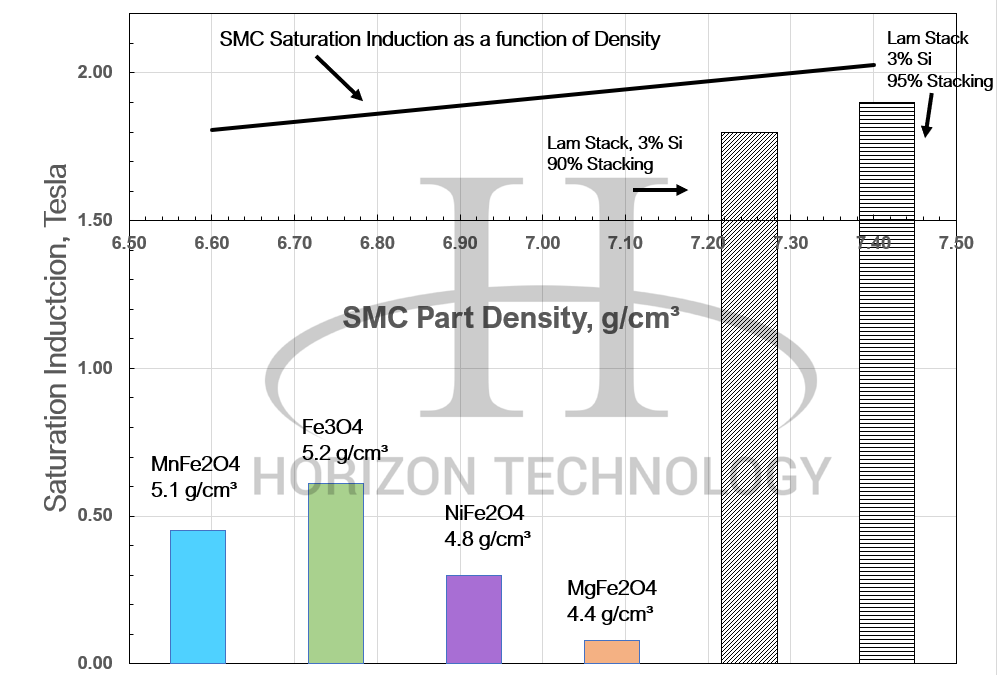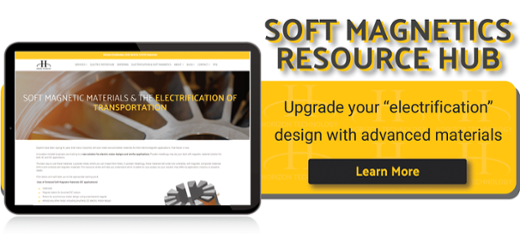If you’re familiar with motors, you know that the axial flux motor has many advantages over other types of motors, such as higher power density, shorter magnetic path, more torque, and better cooling.
So with all of the advantages the axial flux motor has, why aren’t more manufacturers including them in their design?
Here, we’ll discuss the basics of how axial flux motors work and how soft magnetic composites (SMCs) can help solve the most prominent obstacles in producing the axial flux motor.
How Is an Axial Flux Motor Different?
In an axial flux motor (a.k.a. “pancake motor” or “axial gap motor''), the flux is generated parallel to the axis of rotation because of the way it’s wound. This carries the advantage of simplifying the winding process of the motor and reduces overall assembly cost.
Axial flux motors have a more efficient use of copper winding, leading to a greater ability to increase the number of turns and reduce heat caused by the end turn effect.
The usage of axial flux motors was rare until strong permanent magnets became available and brushless DC motors were developed, which could exploit axial geometry’s advantages.
Why Choose Axial Flux Motors?
Axial flux motors hold a unique set of enhancements in relation to other types of motors, including:
- Depending on the package size, they have a greater than 10% higher torque density, with some claims of yokeless axial flux motors as high as 400%.
- Axial flux motors are easier to cool - This is because the windings are not embedded in the steel laminations and often have greater air movement over the coils.
- Because axial flux motors don’t have end turns, the excessive heat generated is eliminated. End turns are necessary in radial flux motors to return the wire into the lamination stack. With axial flux motors, the windings are wrapped around the pole of the motor.
- Improved power to weight ratio makes it ideal for applications such as power tools, drones, wheel hub motors, etc.
- Shape is ideal for manufacturing and more affordable when utilizing SMC technology.
Obstacles to Adopting the Axial Flux Motor (& How PM Can Help)
Today, stacking laminations is still the most common method of manufacturing rotors and stators. This is a lengthy process that involves:
- Stamping or wrapping
- Assembly
- Riveting, welding, or gluing
- Machining axial poles
These processes can be costly and can deform the material’s interior structure through cold-working, which increases the dislocation density and degrades its magnetic properties.
There’s good news though. Powder metallurgy, particularly through the use of soft magnetic composites (SMCs) now allows for high-efficiency motors and can help lower costs. Here’s how:
Higher Intrinsic Saturation = Compact Size
With powder metallurgy and SMCs, you have higher intrinsic saturation values (magnetic moment per volume for a magnetic material). This saturation value is important, since this allows manufacturers to reduce the size of components used in the motor with the same magnetic performance.
The saturation/flux density of SMCs are a function of density and nominally 2.0 Tesla. Assuming a 90-95% stacking efficiency of a 3% silicon, the saturation/flux density of that laminated assembly is going to be down around 1.8 Tesla.

Lower Cost
Cost has been the primary roadblock to greater adoption of axial flux motors, considering assembly and material waste. SMCs provide a more compact motor design, along with net-shape processing of the stator, thereby minimizing or almost eliminating waste.
Higher Torque
Axial flux motors typically show 10% or greater torque for the same volume motor. Some manufacturers quote in excess of 400% torque improvement.
Optimize Your Electric Motor Performance with Soft Magnetic Composites
As you evaluate your next design, keep in mind that soft magnetic composites offer a variety of benefits for axial flux motors, including higher torque, higher intrinsic saturation, and a more compact size. SMCs offer netshape forming, green manufacturing - reduced waste and lower costs.
Ready to learn more about what soft magnetic composites can do for your axial flux electric motor design? Check out our resource page for soft magnetics and electromechanical design:



